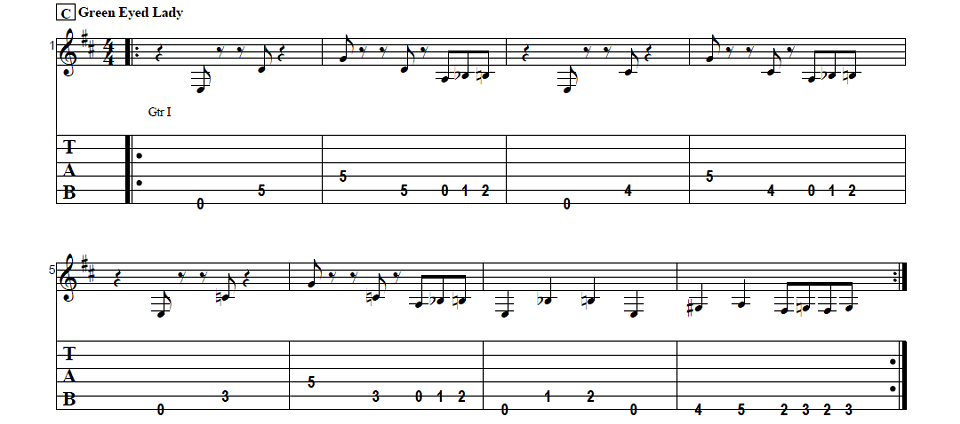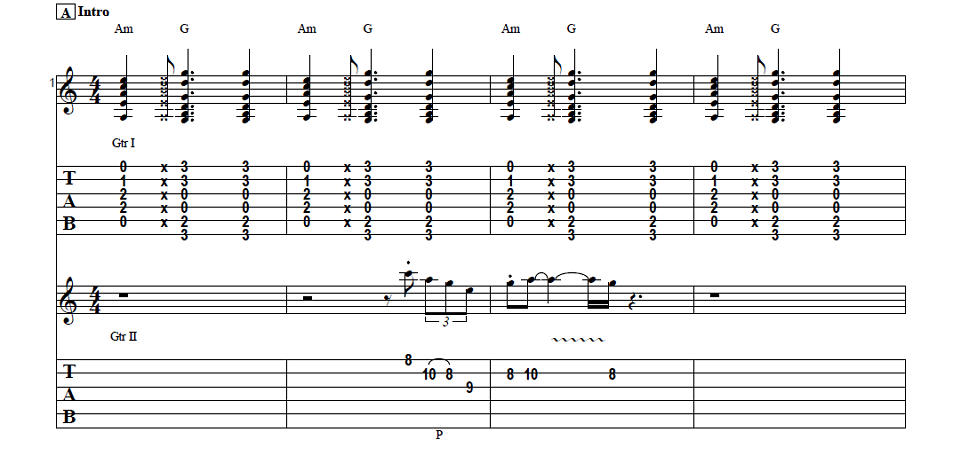Hey, how’s it going this is Darrin Goodman with Guitar Control, I want to teach you how to play “Swing Life Away” by Rise Against. This is a slightly different version from the original. I had a student that wanted to learn this, he was a fairly beginner so I wanted to try to make it a little bit more simpler. So I listened to some different acoustic versions of this song and kind of made this arrangement of it to make it a little bit simpler for the strumming part of it.
[ninja-popup ID=715]
Click on the Tabs button to follow the chords and tabs.
All right, so starting out, we’ve got this Intro here. It’s just open strings on this first part of it, it’s not really a chord per se. So, to start off, we’re going to play the 6th and the 2nd string open simultaneously.
How I’m doing that is I’m playing the 6th string with my pick, and then I’m using my third finger to play the 2nd string and then follows with the 3rd string open, which I’m using my second finger to play the 4th string open, using the pick. That’s the first major.
Then, I’m putting my first finger onto the 2nd fret of the 3rd string and playing that with the 4th string together. The 4th string is open, followed by the 3rd string open, and then the 4th … Fretted the 4th string with my third finger.
So, that’s the First two majors and maybe you’ve played Caad9 before, this is just a slight variation on that. So, we’re on the 3rd fret of the 1st string with my fourth finger, the 3rd fret of the 2nd string with my third finger, 3rd string is open. And then I’m on the 3rd fret of the 5th string with my second finger, and I’m kind of laying it down muting that 4th string.
So we start that on measure three. We got … And then it just simply repeats. So, it does this whole sequence three times.
And then, to a D. So, 4th string open, 2nd fret of the 3rd string with my second finger, 3rd fret of the 2nd string with my third finger, and 2nd fret of the 1st string with my second finger. So down, down, down, down, down. And then rest, that’s the whole intro.
There is one other little thing I want to show you in case you’re going to play this with a friend or something simultaneously, while you have the … And then, starting on the C there, we’ve got these natural harmonics the 2nd guitar is doing. So, it’s the 5th fret of the 2nd string, the 5th fret of the 3rd string, and 5th fret of the 4th string.
Then we go to the 7th fret of the 4th string, back to the 5th fret of the 3rd string, back to the 7th fret of … Or, to the 7th fret of the 2nd string, and then to the 7th fret of the 3rd string.
So, these natural harmonics, if you’ve never done the before, what I’m doing is that I’m at the 5th fret, but I’ve got my finger directly over the fret wire. And I’m not pressing down, I’m just touching the string. So, you pick it, and then you have to lift your finger off so it’ll ring. So, that’s happening simultaneously with the 1st part of the intro.
Then, moving onto the verse. The first chord we have is E minor. So, 6th string is open, 2nd fret of the 5th string with your second finger, 2nd fret of the 4th string with your third finger. Third and 2nd strings are open. First string can be open, as well.
When they strum, they’re just missing that 1st string. So the strum for this is down, down, up, down. One, two and three. This song is in three quarter time. So, you’re just counting to three. So, you’ve got 1, 2, 3.
Then to G5. So, it’s basically just G, but we’re not going to get the 5th string. your third finger is on the 3rd fret of the 2nd string and your fourth finger on the 3rd fret of the 1st string. Third and 4th strings are open. We’re on the 3rd fret of the 6th string with your first finger, and then you’re just letting it roll down to mute that 5th string.
Now, you could play a full on G chord. It’s really not going to make that big of a difference.
Same strum down, down, down, and then to that C Suspended 2, like at the beginning. So, you just move your second finger from the 6th string to the 5th string. Remember, you want it to mute that 4th string and there’s two measures of that so down, down, down, down, down, down and then that whole sequence repeats three times.
Now if you heard there, just a second ago, I kind of altered that strum. So, you can kind of just do whatever you want. You know, just kind of make it your own. You could be like just whatever you like, whatever you think sounds good.
That’s one of the neat things about taking a song like this and kind of picking it apart and making it your own a little bit is that it gives you this freedom to kind of just do whatever you want in there, and you still catch the spirit of the song.
All right after you repeat that part, you go on now to measure 12, when we’ve got D Suspended 2. So, if you take D, hopefully you already know, and remove your second finger, so the 1st string is open.
Fourth string open, the 2nd fret of the 3rd string with your first finger, 3rd fret of the 2nd string with your third finger, and 1st string open. What we did on the intro, is just D Suspended 2 and then a whole measure 14 is just rests. You just rest four beats. And then you just basically repeat the entire … What we just did just starts over again at measure 15.
Starting at measure 15, would be the second half of the verse. So, same thing. We start on E minor, you got the … [inaudible 00:08:39], C Suspended 2, repeat this three times, just like we did before. D Suspended 2. So, this time instead of doing two measures of that and then a rest, there’s three measures. So it’s like, down, down, down, … And then, from there, it moves on into the chorus.
All right, so for the chorus, we’ve just got the same chords that we did before. There is one new chord in there that we’ll look at here in just a second.
We start off on the E minor and strum we’ve got 1, 2, and 3. So, it’s down, down-up, down-up. So, one measure for each chord. So, we start with E minor, down, down-up, down-up, to C Suspended 2, down, down-up, down-up, to G, down, down-up, down-up.
Now, we’ve got this new chord, A Suspended 2. So, for this one 5th string is open. 2nd fret of the 4th string with my second finger. 2nd fret of the 3rd string with my third finger and then strings two and one are open. But again, they are kind of missing that 1st string when they do that strum there. So, if you hit it, that’s great. If you don’t hit it, that’s great too. Either way sounds good. So, same strum 1, 2, and 3, and then we’re back to E minor again, C Suspended 2, D.
That’s the First Eight measures of the chorus. So, we’ve got E minor, C Suspended 2, G, A Suspended 2, E minor, C Suspended 2, D, two measures on that D, then we’re back to E minor again. C Suspended 2, G, A Suspended 2, E minor, C, D.
So, this time on that D, we’ve got the 1, 2, and 3, and 1, 2, 3, and 1, 2, 3, and then you rest on 2, 3.
Then, if you’re looking on your transcription, from there, you go onto the next part that says outro, and it says D.S. So, this is musical direction, “Dal Segno.” So, if you’ll look on your transcription and you go back to the verse, you see this little symbol that kind of looks like a fancy S. That’s the segno sign. So, that’s just telling you to go back and play all the way through that part again before you do this outro part of the song.
All right, so for this outro part of the song, we start on E minor and we’re on that same strum, the 1, 2 and 3, so down, down-up, down-up. So, we have E minor, G, C twice, repeats, into E minor, G, A Suspended 2, C Suspended 2.
After you do that, starting at measure 39, you play those four measures and you’re going to play them twice. And then, it goes on to that next part, starting at measure 43. So, starting at measure 43, we have E minor, still the same strum. Down, down-up, down-up, G, A Suspended 2, C Suspended 2.
Then, we go onto page four of the transcription on C Suspended 2. So two more measures of that. Down, down-up, down-up. Down, down-up, down-up and then you just the open 2nd, 3rd, and 4th strings. One, two, three, just like at the beginning of the song, like on the very intro part. So … And then it just ends on that G as a whole note.
All right. So that’s all of the parts to this song. Like I said, feel free to just kind of experiment around with that strumming pattern in there and stuff, and kind of make it your own, you know? Try singing along with it. You can play along with the track, that helps out a lot too in getting the timing and everything down. Make sure you click on the link, get those tabs, make it easier for you to follow along with.
So if you like the lesson, give me a thumbs up, leave me a comment down below if there’s something you’d like to see myself or one of the other instructors here at Guitar Control do in a future lesson. Make sure to subscribe on our You Tube Channel and we’ll see you in our next video lessons, thanks for watching.





